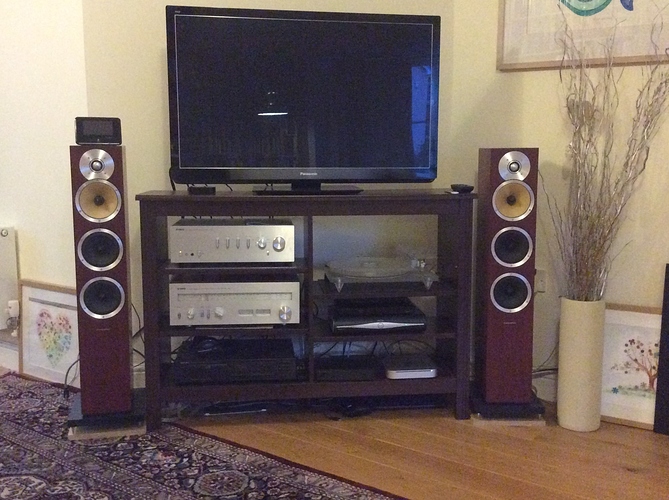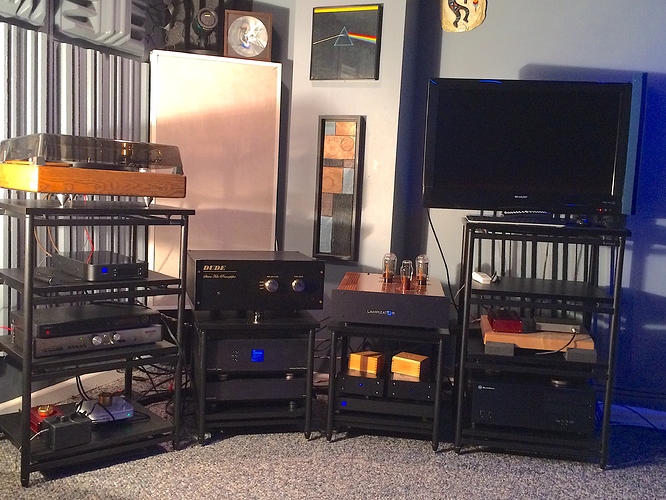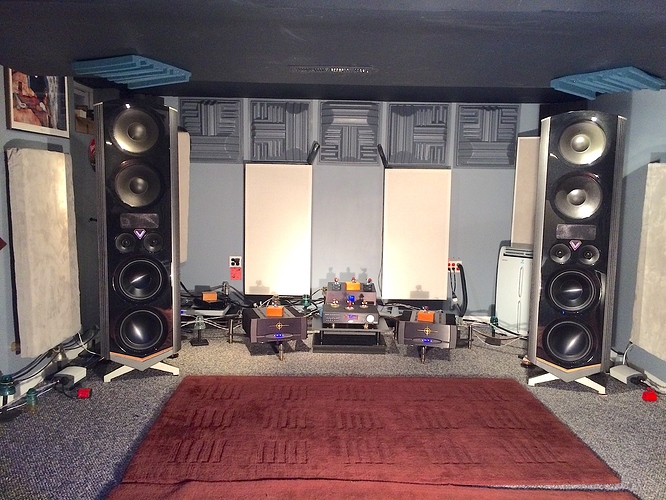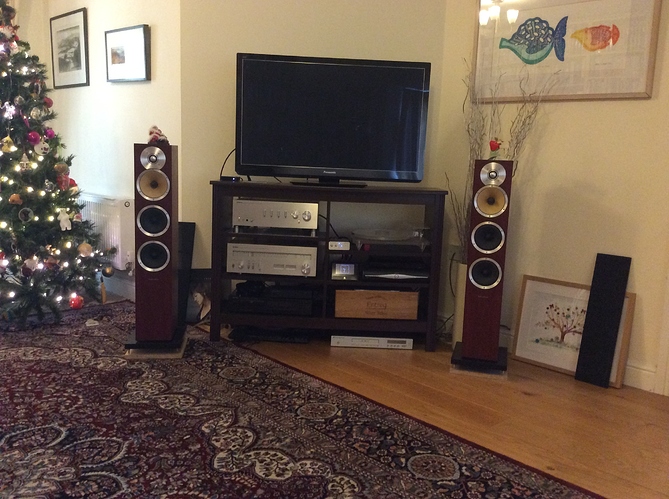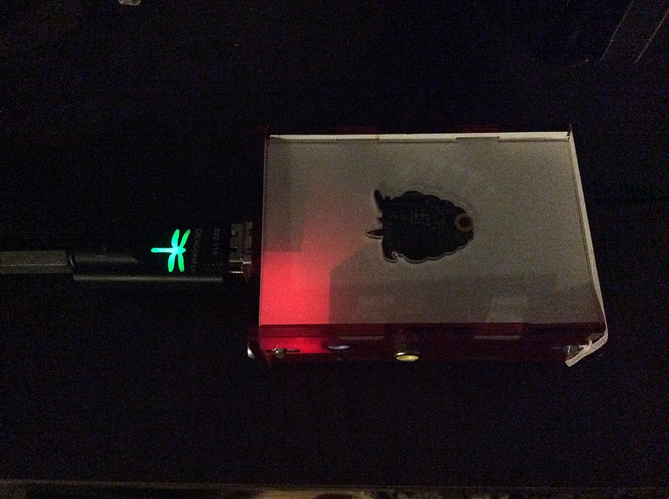@Torstein_Kvamme Use a SonicTransporter and attach to your NAS and router.
First reveal of my modest system. Still a work in progress.
Yamaha RN 501
Yamaha CT 1010 tuner
Rotel 965BX
Clearaudio Emotion with Concept cartridge
CA phono pre amp
Mac Mini loaded with Roon Server and attached to Dragonfly V1.2 Dac
B&W CM8 speakers
Squeezebox Touch and ATV 3 lingering
Enjoying the Roon addition.
Computers: Custom Server
Custom built CAPS inspired Audio PC using jRiver, ROON, dbPoweramp, jPlay, Windows 10, Windows Server 2012 v2, AudiophileOptimizer,
Digital: Lampizator Golden Gate Balanced
Legacy Audio Wavelet Digital Processor (DAC, DSP, Digital Crossover, and Preamp) powered by custom built HDPlex linear power supply and Revelation Audio umbilical cord
UpTone Audio Regen & LPS 1, PS Audio LAN Rover, Sonore MicroRendu,
Speaker System: Legacy Audio Vs with internal 1500 WPC powering bass and sub bass in Rosewood and Black Pearl, 1 pair Legacy Audio LF Extremes in Rosewood
Electronics: Tube Research Labs Dude preamp, One pair: CODA 15.5 stereo amplifiers
Power: 18 10 gauge home runs, PurePower +2000 and +3000 battery backup and regenerators
Cables: Western Electric custom made 10 gauge speaker and power cables and 2 Running Springs HZ Crown Jewels to power PurePower Regenerators, Revelation Audio Umbilical cord for WaVelet.
Wow.That would drive my wife crazy!!! Looks like you’ve had a great journey so far! Maybe my room may look like that in a few years?
Thanks. I’ve been on this journey since I was 21 and began working at the local high end audio store. I’ve always loved music. It takes a very patient, understanding wife and a dedicated listening room to contain all the clutter.
Have you converted the garage or is it a basement room?. There’s a lot of treatment going on in there.
It is a room I built in my basement. One can pretty much listen as loud as you want with out disturbing others. I got the plans from Acoustic Science Corporation.
Room Treatments
I have a long narrow room with relatively low ceilings. The goal was to use diffusion to make the room appear larger sonically. I studied many buildings, churches, auditoriums and movie cinemas plus read as much about acoustic spaces on various audiophile sites as well. I listened to the room with a couple of audiophile friends as each treatment was placed to make sure I was on the right track. Voices in the room sound very natural.
There are only seven absorbers in the room. There are (4)six inch bass traps in each of the corners, a four inch trap adjacent to the V speaker, and another 4 inch trap behind the listening chair. The rest of the room Treatments are diffuser products by Auralex. I use t-fusors along the boundary between the ceiling and end walls to help break up the pressure that tends to build up there. Then I use metro fusors at the first and second reflection points to nullify that problem area.
The Legacy Vs have the best DSP algorithm I’ve heard built into the WaVelet which controls the Vs. WaVelet is a DAC, DSP, Crossover, and preamp built into one awesome product.
The end result is a neutral sounding room that can mimic the acoustics of the venue the music was recorded in.
The reason I ask is that we plan to convert our double garage in the future and I would like to build a dedicated room in part of the conversion. It’s good to see as well as hear how others have used treatment to tune the sound of their set ups.I did originally use Naim gear but I didn’t want to follow the upgrade path so I started again with a range of second hand buys which has refreshed my passion. It’s reminiscent of when I first began my own journey.
If you’re starting with a blank canvas optimise room dimensions before doing anything else.
Bill Duddleston and I discussed my room several times over the years. He felt it’s better to use room treatments like the bass traps in the corners live end/dead end, and pressure zones before using DSP. That way the DSP does not try to do so much and perhaps over correct for room anomalies. Bass always builds up I corners no matter the dimensions of the room.
DSP cannot correct for damping the first and second reflection points and of course those can’t be found until the main speakers are placed. So those must be found after speaker placement. Some people over damp the reflection points. This can lead to a dull, overdamped sound. I use Jim Smith’s advice in “Getting Better Sound” for speaker and listening chair placement.
For your garage project use double dry wall and R channel to hang the drywall from the the studs instead of using screws to fasten it directly to the walls.
Good room dimensions (as in known good ratios) give you the best starting point you can have insofar as minimizing acoustic issues is concerned. Agreed, bass traps and first reflection points are crucial treatments, and there’s no better guide to locating speaker and listening position than GBS. Did you go as far as moving speakers within a grid?
I got that Jim Smith’s manual a few years ago. Great little book and has helped me to understand placement etc.
The Legacy Vs speakers were actually placed and setup by Mr. Bill. Duddleston. So they were not gridded. I do wish they could be moved more towards the seating position. But the HVAC prevents this. I did grid the listening chair after he left. Mr. Duddleston felt his DSP program in built into the WaVelet processor would compensate for the ceiling and sidewalls with no problem. The technology he’s pioneered with Boehmer Audio is truly amazing to experience. So simple to use and effective. It’s considered to be SOTA. I know Jim Smith is not fond of DSP but I don’t believe he’s encountered the WaVelet.
WaVelet works like this. A calibrated microphone is connected to the WaVelet. Then you activate the setup software on your PC or iPad. The microphone is placed ona mic stand and is placed 4 feet in front of the left speaker. Software is activated and the WaVelet emits a series of chirps that measures the volume of each driver. This is repeated for both speakers. All collected information is sent to a powerful server computer that does the number crucnching and the corrected data then sent to WaVelet which controls the speaker output, phase, crossover, and then WaVelet controls the amplifiers which have more than 2500 watts per speaker.
When you listen to the 1812 Overture, does the local PD get 911 calls ?
The Vs play that monstrosity with aplomb. It’s not my favorite recording IBut it is worth hearing once with the Vs plus my pair of 15 inch LF Extreme subwoofers. The system loves the challenge of super complex pieces of music
The Vs have enough power to do that. But they are really a finess speaker. They look like they’d play extremely loud and be totally obnoxious. But they really disappear in the room. If you shut your eyes or listen in the dark you’d never realize you were listening to a speaker that large.
Not that they can’t do amazing things though! The Vs throw a soundstage that knows no room boundaries either left to right or front to back. It’s holographic in nature. Sometimes one is enveloped inside the soundstage. Roger Water’s Amused to Death" is an example. It can sound very 3D in most systems. Except with the Vs one feels part of the show. The massive reserve power provides transient attacks that make the room ripple.
Then switch to Diana Krall, Natalie Merchant, Nina Simone or any of your favorite female vocalists and they provide a private, intimate concert right in your room. One would never know when listening to the ladies sing that they are being reproduced by a monster system. The Vs can sound like a small LS35a except they never lose their place and never bottom out. Played by a a Lampizator DAC, the Vs can get spooky indeed. Right now I’m just breaking in Lampi number 5, the Golden Gate.
Next bring Louie out to play, That man could play the trumpet. Legend has it that when recording the King playing his trumpet he’d have to stand 20 feet away or he’d blow out the mics. The Vs bring the man inside the house. Vibes have that golden glow that only class A amps provide and the CODA 15.5s can turn that trick.
And rock, bring your A list recordings to the party. From a-ha to Zepplin it won’t be the Vs that poop out. As one would expect the Vs with all that power and being extremely efficient at 98db achieve concert levels when ever asked. If a guest wants to go crazy, I’ll step out of the room. Rest assured your ears will give out before the system does. No clipping or distortion here thank you.
The best part? Since I built the room according to the specs provided on the ASC website, the music stays in the room. One can play music anytime of night and not have to worry about disturbing family, friends, or neighbors.
Latest iteration of my budget-ish system. Mac Mini server has been moved to sit with the router. Squeezebox Touch as Endpoint into new CA Dacmagic 100 via USB. Addition of Stillpoints and Entreq grounding box( gifts). Apple TV on standby in case I need to group with my AE driven Boombox in the kitchen. Very happy with sound though I am considering a Cambridge Cd transport. Complete with Santa ornament. I thought I’d escaped the dreaded upgrade disease but I think it may have captured me again. God help me!
Set up my old Pi Model B with Picoreplayer and Dragonfly v1.2. Had to add some Linux code to up the volume but it sounds great. Setting it up for a friend’s system. Currently running wirelessly with no apparent issues.
My roon setup is based around the 30k of lossless ALAC files in redbook quality running on a HP Workstation, with roon and iTunes running. As a longtime iTunes user, all music is imported into my iTunes library and roon takes it from there. Easy and convenient. As a benefit, I can play the same music through iTunes Match with my iDevices when I am not at home.
In our house, I have several Squeezeboxes and Airplay Expresses connected via Ethernet and playback of the ALAC files goes from the Squeezeboxes and APExpresses directly digital to Nubert A-300 powered speakers or through Pro-ject Filterless DAC’s to some 25+ year old Pioneer amplifiers and Quadral Rubin MkII Loudspeakers. Very basic. Not very audiophile, not expensive, not fancy, no need for expensive network players or DAC’s, reduced to the max of what I wanted: to enjoy listening to the music I have, and being able to take the music with me, when I am out of the house or in the car.
I enjoy every minute listening to the music through the roon system with the metadata and links and it helped me rediscover my library many times.
All the best,
Mike
This is my own philosophy.You don’t need expensive ‘audiophile’ gear to enjoy music. I sold a fairly expensive Naim/Spendor set up a few years ago because I wasn’t really enjoying music anymore. I wanted to take myself back to those heady days when I bought my first system, second hand and cobbled together. I still remember the sound of this system. So I sold it and bought a series of carefully selected, modestly priced second hand and new pieces making sure I enjoyed the sound and being careful to maintain this sound as I added equipment. The Squeezebox Touch was one of the most satisfying purchases I ever made. It now resides in my friend’s Roon based system that I helped him to set up. I just upgraded my Pi to the new PI 3. I’d like to add a screen and case to replace my Touch. From now on it will be small, inexpensive changes for me and only if it adds value to my listening experience. Enjoy your set up.
Moving to London in a few months, so sold the SA-1’s I had in my main bedroom. I miss them already 
